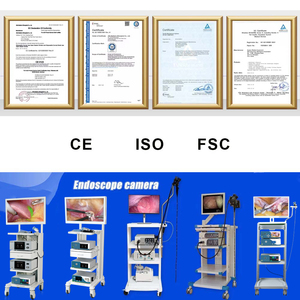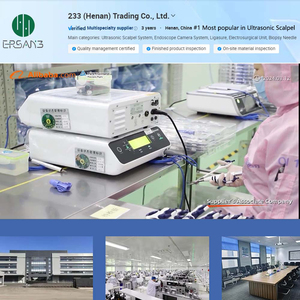
All categories
Featured selections
Trade Assurance
Buyer Central
Help Center
Get the app
Become a supplier

(811 products available)








































Endoscopic towers include various instruments used by health care practitioners. These include:
Laparoscopic Endoscopic Towers
The laparoscopic endoscopic tower is instrumental in doing laparoscopic surgeries since it offers the important needed imaging and instruments to do the very delicate procedures of surgery. The laparoscopic surgery endoscopic tower is crucial in helping perform weight loss operations, gall bladder removal, and ventral hernias.
Arthroscopy Endoscopy Towers
The arthroscopy endoscopic tower is used by OR staff during joint surgeries like knee or hip repairs because it has the right tools for internal joint examination and surgical methods. The high-resolution cameras and monitors of the arthroscopy endoscopic towers enable surgeons to precisely detect and treat conditions like torn ligaments or cartilage wear.
Urology Endoscopy Towers
Like other discipline-specific towers, the urology endoscopy tower is made to satisfy the unique requirements of urinary tract examination and treatment. Patent pending urine resistant instruments and high-powered endoscopes make these towers suitable for procedures on the bladder, kidneys, and prostate. The urology endoscopy tower is normally used in routine checks and advanced surgeries like tumor removal.
Gastrointestinal Endoscopy Towers
The gastrointestinal endoscopic towers are widely used in gastroenterology clinics for both diagnostic and interventional procedures. Flexible endoscopes that enable GI doctors to directly observe the esophagus, stomach, and intestines through video towers. The gastrointestinal endoscopy tower assists doctors in doing biopsies, removing polyps, and treating conditions such as GI bleeding.
ENT Endoscopy Towers
Designed for ear, nose, and throat operations, ENT endoscopic towers augment endoscopic sinus procedures, middle ear surgery, and throat evaluations. High magnification endoscopes and imaging technology make it easy for practitioners to identify and treat various ENT disorders. These endoscopic towers are also very helpful in minimally invasive surgeries that need only tiny openings for access.
Imaging Technology
Imaging technology constitutes one of the major components of an endoscopic tower. The endoscope and camera used provide different magnifications and clarity for the practitioner, depending on the kind of endoscopic procedure to be performed. The imaging resolution is usually measured in HD or 4K since clearer pictures are required for precise diagnosis and surgery. The live images are displayed on a large monitor and enable the health care team to work together to do safe intervention.
Integrated System Components
Every endoscopic tower is designed to be a self-service system complete with appliances that make the endoscopic procedure possible. These include an air supply system, vacuum, light sources, and fiber optic cables. While fiber optics provide endoscopes with bright, focused, and easily bendable light to see inside the body, a pneumatic system runs through the institution and cleans endoscope channels after use. The integration of these systems ensures seamless performance with no interruptions during surgery.
Application Versatility
Today's advanced endoscopic towers have a wide range of application use. These towers can be used in general surgery, urology, orthopedics, and ENT depending on the accessories and imaging capabilities. Health facilities adopt versatile towers that can handle a large variety of endoscopic examinations and surgeries. This versatility also does away with the need for separate systems for every specialty, thus saving on space and financial resources.
User Interface and Control Features
Endoscopic towers are fitted with sensitive touch screens and control panels that allow the medical practitioner to modify imaging parameters, start or close subsystems, and record procedure data. This control ease ensures optimal tower performance during surgery. Practitioners can adjust brightness, zoom in on areas of interest, or switch between imaging modalities with just a few taps to increase comfort for the patient and decrease surgery time.
Safety and Compliance Features
Endoscopic towers are manufactured with tightly fitted legal and safety features. These towers are fitted with surge suppressors and temperature monitors and also have a system that automatically shut offs in case of any danger, hence minimizing any risks. Furthermore, towers are designed to meet hygiene and infection control standards with features like easy-clean surfaces and contamination barriers. These safety precautions are useful for the health facility and the patients undergoing various procedures.
SurgicalApplicatons
Endoscopic towers hold an important position in the surgical areas of health facilities since they are needed for minimally invasive surgery. Surgeons use these towers across specialties like urology, orthopedics, and gastroenterology to perform intricate surgeries precisely while reducing patient recovery time. Offering high-resolution imaging and integrated systems, Endoscopic towers streamline complex procedures, making them indispensable in contemporary surgical care.
Diagnostic Imaging Centers
Diagnostic imaging centers use endoscopic towers in their routine evaluations of patients with internal complaints such as digestive or respiratory problems. These centers offer these towers for use during diagnostic endoscopic procedures like colonoscopies and bronchoscopies. The versatility and accuracy of these towers make them valuable in diagnostic contexts where precise internal visualization must be done to diagnose accurately and treat diseases.
Outpatient Clinics and Ambulatory Surgical Centers
Endoscopic towers are commonly used in outpatient care and ambulatory surgical centers. They provide facilities for diagnosis and treatment of different medical conditions without the need for long-term hospitalization. These cost-effective endoscopic towers allow ASCs to do a variety of minimally invasive surgery procedures, from managing urinary tract problems to performing arthroscopic joint surgeries. Both efficiency and accessibility make these towers an important part of outpatient surgical services.
Training and Research Institutions
Medical schools and research institutions employ endoscopic towers for surgical training and clinical research. These tools enable trainee surgeons to acquire the skills needed for modern surgical approaches by providing a practical learning experience in endoscopic techniques. In clinical research, various studies sponsored using these endoscopic towers improve practices and technologies in various specialties while enhancing patient outcomes.
Telemedicine and Remote Surgery
In the current era of telemedicine, endoscopic towers are gaining a place in remote surgery and consultation models. These towers are used in distant surgery technologies that enable specialists to assist in surgery from anywhere in the world while still having access to live-endoscopic feeds. This innovation has greatly improved health care delivery, especially in remote areas with no access to specialized services. Endoscopic towers have a key role in enhancing accessibility and collaboration in modern medical practice.
Image Quality
Healthcare practitioners should look for endoscopic towers with advanced imaging technology such as HD or 4K scopes and intensity light sources. Important details of internal organs and tissue are critical for diagnosis and surgery. The clarity of the images directly affects the accuracy of surgery and the outcomes that patients get. Therefore, choose an endoscopic tower with good-resolution imaging capabilities.
Compatibility with Procedures
Ensure that the selected endoscopic tower is compatible with the various procedures at the healthcare facility. This means that depending on the specialty of the hospital, the tower may have to be fitted with particular attachments, such as an arthroscopy endoscopic tower for orthopedic surgery. A versatile tower used in various endoscopic procedures will decrease the need for extra equipment and therefore save space and money.
Usability
The endoscopic tower's user interface should be easy to use for the medical practitioners who will be operating it. For convenient operations during crucial procedures, one should look for systems with touch control and simple designs. Easy-to-navigate controls and monitors will mean less time spent on adjustments during the surgery and, therefore, more efficient procedures with better outcomes for the patients.
Reliability and Durability
When purchasing an endoscopic tower, one must consider the reliability and longevity of the equipment. These tools are normally used in a very demanding environment and, therefore, ought to be manufactured with strong materials and robust construction designs. A dependable tower ensures that surgeries will proceed without disruption and that will continue working at maximum capacity for several years to come. Towers that come with good manufacturer warranties offer additional protection against eventualities of failure.
Integrated Systems and Customization
Endoscopic towers are equipped with many integrated systems such as light sources, air supply, and water. This enables the running of the procedure in a very smooth manner. However, having a tower that has customizable components may also benefit the health care facility since they would be able to equip them with the appropriate tools necessary for different procedures. The integration and customization of factors will further enhance the efficiency of the procedure and expand its scope.
The endoscopic tower's function is to provide health practitioners with imaging, light, and instrument systems to aid in the performance of minimally invasive surgeries, thereby making the procedure more efficient and safe for patients.
Laparoscopic Endoscopic Towers are equipped with cameras, monitors, and special laparoscopic tools that perform internal operations using small incisions while providing detailed images of the interior organs on a large-screen monitor.
Endoscopic towers have been fitted with touchscreen technology to operate them easily during surgery, thus enhancing efficiency and precision during the operation.
They are considered vital tools in outpatient and ambulatory surgical centers because they provide facilities for diagnosing and treating various conditions with great accuracy, thus resulting in quick patient turnover and improved health outcomes.
Yes, endoscopic towers are used for surgical procedure training in medical schools and residency programs that provide trainees with access to advanced technology for performing complex minimally invasive procedures.